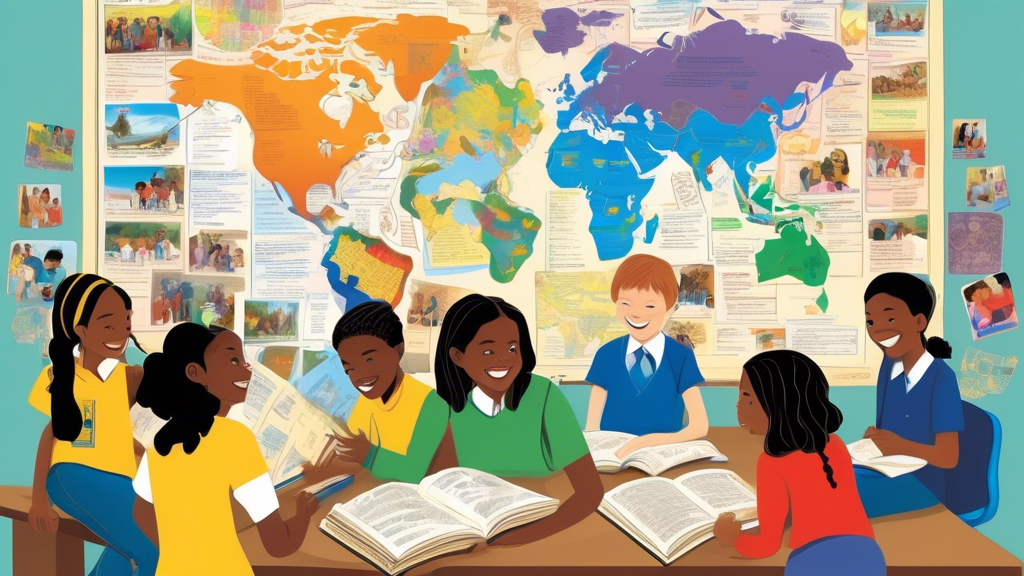Introduction to the Oxford Picture Dictionary: A Comprehensive Learning Tool
The Oxford Picture Dictionary is a groundbreaking resource designed to facilitate language learning through the power of visual aids. Renowned for its extensive collection of vivid illustrations, this dictionary serves as an invaluable tool for learners of all ages and proficiency levels. By pairing images with words, the Oxford Picture Dictionary makes it easier for learners to connect concepts, making vocabulary acquisition not only more effective but also enjoyable. Whether you’re a student, teacher, or self-learner, this dictionary offers something for everyone, making it a versatile addition to any language learning arsenal.
One of the major advantages of the Oxford Picture Dictionary is its user-friendly layout that covers a broad spectrum of topics, from everyday objects to complex concepts. This inclusivity ensures that learners can steadily build their vocabulary across various contexts. Additionally, the dictionary features bilingual translations, example sentences, and pronunciation guides, providing a comprehensive approach to language learning. Given its design and functionality, the Oxford Picture Dictionary proves to be particularly beneficial in educational settings, language institutes, and for anyone involved in self-study.
“`html
Introduction to the Oxford Picture Dictionary: A Comprehensive Learning Tool
The Oxford Picture Dictionary (OPD) is an invaluable resource for language learners around the world. Designed to bridge the gap between visual learners and language acquisition, the OPD is a comprehensive educational aid that combines vivid imagery with precise definitions, creating an effective and engaging tool for mastering new languages.
Overview of the Oxford Picture Dictionary
The Oxford Picture Dictionary stands out due to its meticulous design and user-friendly approach. With over 4,000 words and phrases depicted through artwork, the dictionary covers a broad spectrum of topics relevant to everyday life. Each word or phrase is presented alongside a clear, context-driven illustration, facilitating better understanding and retention.
Every section of the dictionary is organized thematically, covering essential categories such as food, transportation, work, and housing. By situating vocabulary within real-life contexts, users can better grasp the practical use of new terms. This thematic structure is particularly effective for learners at all levels, from beginners to advanced students, making the OPD a versatile tool for a wide audience.
Key Features and Benefits for Language Learners
The Oxford Picture Dictionary offers an array of features designed to enhance the learning experience:
- Visual Learning: High-quality illustrations help to build strong mental associations, making it easier for learners to recall vocabulary.
- Bilingual Support: Many editions offer side-by-side translations in multiple languages, which is a significant advantage for multilingual classrooms.
- Practical Usage: Vocabulary is not only illustrated but also presented in sentences and scenarios that mimic real-life use, aiding contextual understanding.
- Interactive Elements: Some editions include interactive media, digital resources, and exercises that complement traditional learning methods.
- Accessibility: The dictionary is designed to be accessible to learners of all ages and educational backgrounds, making it a universal tool.
One of the standout benefits of the Oxford Picture Dictionary is its ability to cater to different learning styles. Whether a learner prefers visual, auditory, or kinesthetic learning, the OPD’s multifaceted approach ensures that language acquisition is both comprehensive and engaging.
Target Audience and Applicability in Various Learning Environments
The Oxford Picture Dictionary is suitable for a wide range of users:
- Students: Ideal for classroom use, the OPD is an excellent supplement to traditional textbooks, providing clear and engaging visuals that help reinforce vocabulary.
- Educators: Teachers can utilize the OPD as a powerful teaching aid, incorporating its visuals into lesson plans to enhance the instructional experience.
- Self-Learners: Individuals studying a new language independently will find the dictionary’s systematic approach and interactive components invaluable.
- SPECIAL Programs: The OPD is also highly beneficial in specialized language programs, such as ESL (English as a Second Language) and for learners with specific language learning needs.
- Parents: Families can use the OPD to help children build foundational vocabulary in a fun and accessible way, making language learning a shared and enjoyable experience.
In terms of applicability, the Oxford Picture Dictionary is versatile. It can be integrated into various educational settings, including formal classrooms, informal study groups, and even as a tool for virtual learning environments. With the rise of remote education, the digital versions of the OPD offer interactive elements that can be easily accessed online, providing a seamless learning experience regardless of location.
Overall, the Oxford Picture Dictionary is more than just a dictionary; it is a comprehensive learning tool that fosters language acquisition in an effective, engaging, and practical manner. By leveraging the power of visual learning and providing resources that cater to diverse educational needs, the OPD stands out as a pivotal resource for language learners worldwide.
“`
Enhancing Vocabulary Retention with Visual Learning
The Role of Images in Aiding Memory and Comprehension
In the realm of language acquisition, one of the most effective strategies for enhancing vocabulary retention is the use of visual learning. Visual aids play a crucial role in anchoring new words to images, which helps in creating lasting mental associations. When learners can visualize a word, they are more likely to understand and remember it. Research in cognitive science demonstrates that humans process and recall visual information more efficiently than text alone. This capability is harnessed to its full potential by the Oxford Picture Dictionary, which integrates detailed illustrations with new vocabulary, making it an indispensable tool for language learners.
How the Oxford Picture Dictionary Leverages Visual Aids to Enhance Language Acquisition
The Oxford Picture Dictionary (OPD) employs over 4,000 images meticulously designed to represent a wide range of everyday vocabulary. Each entry pairs a word with a clear, context-relevant image, facilitating better understanding and recall. This visual approach supports learners in making connections between words and their meanings, moving beyond rote memorization to genuine comprehension.
A key advantage of the Oxford Picture Dictionary is its thematic organization. Words are grouped into logical categories, such as household items, foods, and nature, allowing learners to build their vocabulary in context. This thematic structure mirrors the way we encounter new words in real life and helps learners to see how individual words fit into larger semantic fields. As a result, language learners can develop a more coherent and usable vocabulary.
The dictionary also features practical, real-life scenes and scenarios, such as shopping at a grocery store or visiting a doctor’s office. These contextual scenes help learners by placing vocabulary within a practical framework, thereby reinforcing the words through applicable situations. Additionally, the dictionary includes example sentences and phrases alongside images, which further aids in understanding how words and expressions are used in spoken and written communication.
Case Studies or Testimonials from Educators and Students
Educational experts and language instructors have long praised the OPD for its effectiveness in enhancing vocabulary retention. Ellen Robertson, a seasoned ESL teacher, notes, I have observed a noticeable difference in my students’ ability to remember new words when they learn them with accompanying images from the Oxford Picture Dictionary. The visuals make abstract concepts tangible and memorable.
Students, too, have shared positive feedback about their experiences with the OPD. Maria Lopez, a student who recently started learning English, shares, Using the Oxford Picture Dictionary has been a game-changer for me. The pictures help me understand and remember new words quickly, which has made me more confident in speaking and writing.
An in-depth study conducted by the University of Michigan explored the dictionary’s impact on vocabulary acquisition among English language learners. The research revealed that students using the OPD showed a 30% higher retention rate of new vocabulary words compared to those using traditional text-based dictionaries. The study concluded that the effectiveness of the OPD is attributed to its integration of visual aids, which engage multiple cognitive processes simultaneously.
Another compelling testimonial comes from an adult literacy program in Toronto. According to program coordinator John Matthews, Many of our learners are visual or kinesthetic learners, and the Oxford Picture Dictionary meets their needs perfectly. It’s also an inclusive resource—whether our students are beginners or advanced learners, they find value in the images and contextual learning it offers.
In sum, the combination of visually rich content and thematic organization enables the Oxford Picture Dictionary to unlock the full potential of language learners. By linking images with words, the OPD fosters better retention and comprehension, making it a cornerstone tool for vocabulary development in a variety of educational settings.
Practical Applications and Effective Study Tips
The Oxford Picture Dictionary isn’t just a reference book; it’s a versatile educational tool that can be seamlessly incorporated into various learning routines. Whether you are a student, educator, or self-learner, there are myriad ways to leverage this resource to enhance your language learning experience. Here, we explore some innovative methods to use the Oxford Picture Dictionary in daily practice, how to integrate it into classroom activities and personal study sessions, and offer tips for maximizing learning outcomes and retaining new vocabulary.
Innovative Ways to Use the Oxford Picture Dictionary in Daily Practice
Integrating the Oxford Picture Dictionary into your daily language practice can transform your learning journey. One effective technique is to set aside a dedicated time each day to explore a specific theme or category from the dictionary. By doing this, you gradually build your vocabulary in meaningful contexts.
Another innovative approach is to use the dictionary as a thematic guide. For example, you can explore a theme like grocery shopping before heading to the store. Take a few minutes to learn relevant vocabulary and then apply it in real-life situations. This not only reinforces your memory but also gives practical context to new words.
Additionally, incorporating the Oxford Picture Dictionary into your digital life can be highly effective. Many people benefit from taking pictures of specific pages and reviewing them on their phones during idle times. This technique helps to constantly reinforce learning through spaced repetition.
Integrating the Dictionary into Classroom Activities
For educators, the Oxford Picture Dictionary can become an indispensable part of classroom activities. One method is to use it as a visual aid during lessons. For instance, while introducing new vocabulary, project the relevant page onto a screen for the entire class to see. This visual association aids in better retention and understanding.
Group activities can be significantly enhanced by incorporating the dictionary. Create assignments where students are tasked with preparing dialogues or role-plays based on themes from the book. This not only improves language use but also encourages collaboration and creativity among students.
Using the Oxford Picture Dictionary as a reference tool during writing exercises can also be very effective. Encourage students to refer to it when constructing sentences or paragraphs. This practice helps ingrains new vocabulary in their written language skills as well.
Personal Study Routines for Maximizing Learning Outcomes
If you’re a self-learner, personalizing your study routine with the Oxford Picture Dictionary can lead to significant improvements in your language skills. Start by setting clear, achievable goals for each study session. For example, aim to learn a set number of new words from a particular category each day.
Creating flashcards based on the dictionary’s content is another powerful tool. Write the word on one side and the corresponding image on the other. This combines visual learning with active recall, which are both potent strategies for memory enhancement.
Incorporate auditory learning by describing the pictures in the dictionary out loud. This helps in reinforcing pronunciation and helps integrate different modes of learning. Recording yourself and playing it back can further enhance your articulation and fluency.
Tips for Retaining New Vocabulary
The effectiveness of the Oxford Picture Dictionary lies not just in its content but also in how you interact with it. Here are some tips to ensure that the vocabulary you learn sticks with you:
- Use Mnemonics: Create associations between new vocabulary and familiar concepts or visuals. The dictionary’s images can serve as a starting point for these mnemonic devices.
- Daily Review: Regularly revisit the pages and themes you have covered. Spaced repetition is crucial for long-term retention.
- Apply in Context: Try to use new words in sentences or real-life conversations. This practical application helps solidify your understanding and recall of the words.
- Diversify Learning Methods: Combine the Oxford Picture Dictionary with other resources like language apps, online exercises, and conversational practice to offer multiple contexts for new vocabulary.
- Consistency: Consistent, short study sessions are more effective than sporadic, long ones. Make the dictionary a regular part of your daily routine, integrating it into your lifestyle rather than treating it as a chore.
In conclusion, the Oxford Picture Dictionary offers numerous opportunities for practical application and effective learning techniques that can significantly enhance your language learning journey. By creatively integrating it into your daily practices, classroom activities, and personal study routines, you can maximize the retention and comprehension of new vocabulary. The key to success lies in the consistency and variety of your learning methods, making the most of this versatile tool.
Every Picture Tells A Story
The Oxford Picture Dictionary stands out as a powerful and versatile tool for language learners of all ages and proficiency levels. By combining visually engaging content with well-structured vocabulary lists, this dictionary not only makes learning more enjoyable but also significantly enhances retention and recall. The strategic use of images helps bridge the gap between words and their meanings, making it easier for learners to grasp new concepts and retain them over the long term.
Through the various applications and study tips outlined, it is clear that the Oxford Picture Dictionary can be seamlessly integrated into both classroom and personal study routines. Whether used in group activities or individual practice, this dictionary provides a robust foundation for building a rich and diverse vocabulary. Its effectiveness is further corroborated by numerous testimonials from educators and students who have witnessed substantial improvements in their language skills.
In conclusion, the Oxford Picture Dictionary is more than just a reference book; it is an invaluable resource for anyone looking to unlock the full potential of their language learning journey. By leveraging the power of visual learning, it opens up new pathways to understanding and communication, empowering learners to achieve their linguistic goals with confidence and ease.



